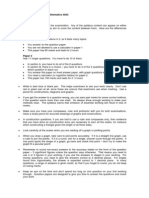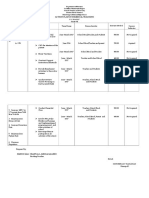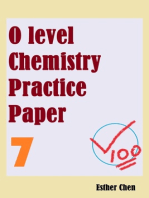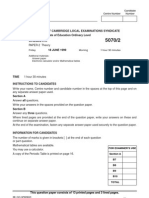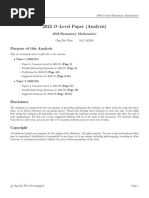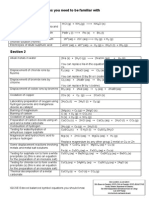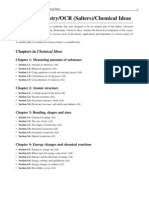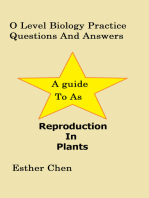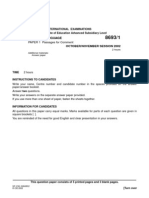0 ratings0% found this document useful (0 votes)
105 views5070 w11 Ms 41
5070 w11 Ms 41
Uploaded by
mstudy123456Mark scheme is published as an aid to teachers and candidates, to indicate the requirements of the examination. It shows the basis on which Examiners were instructed to award marks. It does not indicate the details of the discussions that took place at an Examiners' meeting before marking began.
Copyright:
© All Rights Reserved
Available Formats
Download as PDF, TXT or read online from Scribd
5070 w11 Ms 41
5070 w11 Ms 41
Uploaded by
mstudy1234560 ratings0% found this document useful (0 votes)
105 views4 pagesMark scheme is published as an aid to teachers and candidates, to indicate the requirements of the examination. It shows the basis on which Examiners were instructed to award marks. It does not indicate the details of the discussions that took place at an Examiners' meeting before marking began.
Original Title
5070_w11_ms_41
Copyright
© © All Rights Reserved
Available Formats
PDF, TXT or read online from Scribd
Share this document
Did you find this document useful?
Is this content inappropriate?
Mark scheme is published as an aid to teachers and candidates, to indicate the requirements of the examination. It shows the basis on which Examiners were instructed to award marks. It does not indicate the details of the discussions that took place at an Examiners' meeting before marking began.
Copyright:
© All Rights Reserved
Available Formats
Download as PDF, TXT or read online from Scribd
Download as pdf or txt
0 ratings0% found this document useful (0 votes)
105 views4 pages5070 w11 Ms 41
5070 w11 Ms 41
Uploaded by
mstudy123456Mark scheme is published as an aid to teachers and candidates, to indicate the requirements of the examination. It shows the basis on which Examiners were instructed to award marks. It does not indicate the details of the discussions that took place at an Examiners' meeting before marking began.
Copyright:
© All Rights Reserved
Available Formats
Download as PDF, TXT or read online from Scribd
Download as pdf or txt
You are on page 1of 4
UNIVERSITY OF CAMBRIDGE INTERNATIONAL EXAMINATIONS
GCE Ordinary Level
MARK SCHEME for the October/November 2011 question paper
for the guidance of teachers
5070 CHEMISTRY
5070/41 Paper 4 (Alternative to Practical), maximum raw mark 60
This mark scheme is published as an aid to teachers and candidates, to indicate the requirements of
the examination. It shows the basis on which Examiners were instructed to award marks. It does not
indicate the details of the discussions that took place at an Examiners meeting before marking began,
which would have considered the acceptability of alternative answers.
Mark schemes must be read in conjunction with the question papers and the report on the
examination.
Cambridge will not enter into discussions or correspondence in connection with these mark schemes.
Cambridge is publishing the mark schemes for the October/November 2011 question papers for most
IGCSE, GCE Advanced Level and Advanced Subsidiary Level syllabuses and some Ordinary Level
syllabuses.
Page 2 Mark Scheme: Teachers version Syllabus Paper
GCE O LEVEL October/November 2011 5070 41
University of Cambridge International Examinations 2011
1 26 (1) cm
3
[1]
2 (a) red to blue (1)
(b) (i) hydrogen (1) pops in a flame (1)
(c) (i) effervescence or fizzing or bubbles given off (1)
Not gas evolved
(ii) carbon dioxide (1) turns lime water milky or white (1)
ecf on O
2
[6]
3 (a) 0.48 (1) g
(b) (i) silver/grey/shiny metal/solid (1)
(ii) white solid/powder (1)
(c) to ensure constant weight or that reaction was complete (1)
(d) (i) 0.8 (1) g
(ii) 0.32 (1) g
(e) 0.48/24 = 0.02 0.32/16 = 0.02 (1)
MgO (1)
(f) (i) MgO + 2HCl MgCl
2
+ H
2
O (1)
or + H
2
SO
4
+ HNO
3
(ii) basic (1) [10]
4 (c) (1) [1]
5 (b) (1) [1]
6 (d) (1) [1]
7 (d) (1) [1]
8 (b) (1) [1]
Page 3 Mark Scheme: Teachers version Syllabus Paper
GCE O LEVEL October/November 2011 5070 41
University of Cambridge International Examinations 2011
9 (a) 1.22 (1) g
(b) to allow gas/carbon dioxide to escape (1)
(c) red/pink to yellow (1)
(d) 24.1 41.1 28.5 1 mark for each correct row or column (3)
0.0 17.6 4.8
24.1 23.5 23.7
Mean value = 23.6 (1) cm
3
(e) 0.00236 (1)
(f) 0.00236 (1)
(g) 0.0236 (1)
(h) 0.05 (1)
(i) 0.0264 (1)
(j) MgCO
3
+ 2HCl MgCl
2
+ CO
2
+ H
2
O (1)
(k) 0.0132 (1)
(l) (i) 84 (1)
(ii) 1.11 (1) g
(iii) 1.11/1.22 = 91% (1) [17]
Page 4 Mark Scheme: Teachers version Syllabus Paper
GCE O LEVEL October/November 2011 5070 41
University of Cambridge International Examinations 2011
10 (a) transition metal or transition metal ions present (1)
(b) (i) blue ppt (1)
(ii) insoluble in excess (1)
(c) (i) blue ppt (1)
(ii) soluble forming a DEEP blue solution (1)
(d) HNO
3
/AgNO
3
(2)
White ppt (1)
CuCl
2
(1) [9]
11 (a) 26.8, 28.5, 30.3, 31.2 (1) all correct
1.8, 3.5, 5.3, 6.2 (1) all correct
(b) all points plotted correctly (1)
two intersecting straight lines, the first of which must pass
through zero (2).
points joined by a curve or a series of straight lines at intersection (1)
(c) (i) 0.34 (1) g
(ii) 0.70 (1) g
(iii) Fe + CuSO
4
FeSO
4
+ Cu (1)
(iv) redox or displacement or exothermic (1)
(v) 50 conc
n
/ 1000 = 0.70/56 (1)
Conc
n
= 0.25 (1) mol/dm
3
(d) blue colour disappears
or red deposit/solid/copper at bottom of beaker (1) [12]
[with all graphical answers please read candidates graph and to accuracy of half small
square]
You might also like
- Free ESL Lesson Plans To DownloadDocument12 pagesFree ESL Lesson Plans To DownloadSuhanto Kastaredja64% (56)
- Answers To End-Of-Chapter QuestionsDocument1 pageAnswers To End-Of-Chapter QuestionsMP3 MusicNo ratings yet
- L A Level Biology MS Jan 05Document180 pagesL A Level Biology MS Jan 05annakaranovaNo ratings yet
- Examiner Tips For OL Mathematics 4024 FINALDocument3 pagesExaminer Tips For OL Mathematics 4024 FINALTerence Tay100% (1)
- O Level Biology Practice Questions And Answers Transport In HumanFrom EverandO Level Biology Practice Questions And Answers Transport In HumanNo ratings yet
- Winter Concert Program TemplateDocument3 pagesWinter Concert Program Templatearnoldlee1No ratings yet
- Action Plan in RemedialDocument2 pagesAction Plan in Remedialzitadewi43589% (27)
- NewsBreak Lesson PlanDocument3 pagesNewsBreak Lesson Plandaraumang75% (4)
- University of Cambridge International Examinations General Certificate of Education Ordinary LevelDocument20 pagesUniversity of Cambridge International Examinations General Certificate of Education Ordinary Levelmstudy123456No ratings yet
- Cambridge O Level: Chemistry 5070/11Document16 pagesCambridge O Level: Chemistry 5070/11Jack DoeNo ratings yet
- O Level Chemistry NotesDocument195 pagesO Level Chemistry NotesZarah Tahir60% (5)
- Sample Questions - Chapter 15Document6 pagesSample Questions - Chapter 15Rasel IslamNo ratings yet
- Organic Chemistry - Alkanes, Alkenes, Alcohols, Carboxylic Acids, Ester, Macromolecules, Polymer, Polyethene, Polythene, Homologous SeriesDocument19 pagesOrganic Chemistry - Alkanes, Alkenes, Alcohols, Carboxylic Acids, Ester, Macromolecules, Polymer, Polyethene, Polythene, Homologous SeriesOpen200993% (28)
- Chemistry 5070 Complete Notes For O LevelDocument1 pageChemistry 5070 Complete Notes For O LevelBilal Hussain ShahNo ratings yet
- Cambridge IGCSE Chemistry Paper 32 June 2014Document12 pagesCambridge IGCSE Chemistry Paper 32 June 2014FazalAmin100% (1)
- A and As Level Physics Syllabus 2010Document72 pagesA and As Level Physics Syllabus 2010amachqNo ratings yet
- Worksheet 1 - Kinetic Particle TheoryDocument2 pagesWorksheet 1 - Kinetic Particle TheoryFandy ArdyNo ratings yet
- Preparation of SaltsDocument8 pagesPreparation of SaltsRose MusariraNo ratings yet
- Chemistry AOS1 Unit 3 NotesDocument34 pagesChemistry AOS1 Unit 3 NotesAnonymous oqlnO8e0% (1)
- Maths Past PaperDocument12 pagesMaths Past PaperPraveen PeterNo ratings yet
- IGCSE MATHS PAST PAPER 580 - 2004 - QP - 3Document16 pagesIGCSE MATHS PAST PAPER 580 - 2004 - QP - 3Hassan mahmud100% (3)
- Topic - 17 TransformationsDocument88 pagesTopic - 17 TransformationsJorifNo ratings yet
- Page 1 of 5Document5 pagesPage 1 of 5Jagdeep PandeyNo ratings yet
- All FlashCards of 9701 Chemistry CAIE As LevelDocument1,308 pagesAll FlashCards of 9701 Chemistry CAIE As LevelAdam BeyNo ratings yet
- Chemistry 5070 ECRsDocument79 pagesChemistry 5070 ECRsPif SchoolNo ratings yet
- Problem Solving: Dr. Saima Shabbir, MSE, ISTDocument15 pagesProblem Solving: Dr. Saima Shabbir, MSE, ISTOsama Aadil SaadiNo ratings yet
- Mathematics: Common Entrance Examination at 13+Document16 pagesMathematics: Common Entrance Examination at 13+ayesha safdarNo ratings yet
- Cambridge International AS & A Level: CHEMISTRY 9701/21Document16 pagesCambridge International AS & A Level: CHEMISTRY 9701/21nmeghani325No ratings yet
- Physics 9 O Level TestDocument4 pagesPhysics 9 O Level TestAllam S/o Mumtaz Ali Tunio0% (1)
- 0625 PHYSICS: MARK SCHEME For The May/June 2013 SeriesDocument4 pages0625 PHYSICS: MARK SCHEME For The May/June 2013 SeriesHany ElGezawyNo ratings yet
- Bar Charts and Histograms WITH GRATEFUL THANKS TO MR BARTONDocument10 pagesBar Charts and Histograms WITH GRATEFUL THANKS TO MR BARTONMathsArkAcademyNo ratings yet
- June 1999 Paper 2Document16 pagesJune 1999 Paper 2Yasir100% (1)
- 5070 Chemistry ECR v1.1 080316Document153 pages5070 Chemistry ECR v1.1 080316warisNo ratings yet
- FT 12 Gr10 P2 Qs (General Phy)Document10 pagesFT 12 Gr10 P2 Qs (General Phy)farogh hamidNo ratings yet
- O Level Physics 2018 MarkschemeDocument10 pagesO Level Physics 2018 MarkschemefordalNo ratings yet
- 0620 Chemistry: MARK SCHEME For The October/November 2006 Question PaperDocument4 pages0620 Chemistry: MARK SCHEME For The October/November 2006 Question PaperVarun PanickerNo ratings yet
- Atomic Structure MCQ W AnsDocument6 pagesAtomic Structure MCQ W AnsHovan Tall Nut TanNo ratings yet
- 4024 w13 QP 11 PDFDocument20 pages4024 w13 QP 11 PDFChristine SetiawanNo ratings yet
- Mathematical Studies IB Worked SolutionsDocument38 pagesMathematical Studies IB Worked SolutionsJuanita DomínguezNo ratings yet
- Centripetal Force - The Physics HypertextbookDocument8 pagesCentripetal Force - The Physics HypertextbookjinkazamaNo ratings yet
- Chemistry IA 1 (Flame Test)Document2 pagesChemistry IA 1 (Flame Test)javison_501No ratings yet
- 2022 O-Level E-Math 4048 AnalysisDocument31 pages2022 O-Level E-Math 4048 AnalysisJong Kook Kim100% (1)
- A Level Physics PracticalDocument9 pagesA Level Physics PracticalKelvin Yeung100% (2)
- Cambridge IGCSE Physics (3rd Edition) by Tom Duncan and Heather KennettDocument2 pagesCambridge IGCSE Physics (3rd Edition) by Tom Duncan and Heather Kennettubaid_nedianNo ratings yet
- Symbol Equations You Need To Be Familiar WithDocument3 pagesSymbol Equations You Need To Be Familiar WithKamrul Alam MasumNo ratings yet
- Chem Insights Chapter 7 WSDocument3 pagesChem Insights Chapter 7 WSwakakkaNo ratings yet
- Chemical Ideas ContentsDocument4 pagesChemical Ideas ContentsJake RileyNo ratings yet
- Physics Revision ChecklistDocument24 pagesPhysics Revision ChecklistShifa RizwanNo ratings yet
- 'O' Level Chemistry Paper 1 - 2012Document16 pages'O' Level Chemistry Paper 1 - 2012MayureshSoowamberNo ratings yet
- Moles and Stoichiometry Igcse Only Complete 2014 With Marking Scheme Protected PDFDocument55 pagesMoles and Stoichiometry Igcse Only Complete 2014 With Marking Scheme Protected PDFIlsa Marium ChaudharyNo ratings yet
- Chem 5070 Checklist O Level ChemistryDocument32 pagesChem 5070 Checklist O Level ChemistryrabtayNo ratings yet
- Prelim 2 p3 2011 (For Sharing)Document14 pagesPrelim 2 p3 2011 (For Sharing)Yee Kai TanNo ratings yet
- Grade Thresholds - November 2023: Cambridge O Level Chemistry (5070)Document1 pageGrade Thresholds - November 2023: Cambridge O Level Chemistry (5070)Pahal KalraNo ratings yet
- 9701 s09 QP 4Document20 pages9701 s09 QP 4Hubbak KhanNo ratings yet
- Circles Worksheet, Geometry Revision From GCSE Maths TutorDocument2 pagesCircles Worksheet, Geometry Revision From GCSE Maths Tutorgcsemathstutor50% (2)
- Physics ATP NotesDocument39 pagesPhysics ATP NotesAmmara IftikharNo ratings yet
- Algebra 1.6 Factorising Linear Differentiated WorksheetDocument1 pageAlgebra 1.6 Factorising Linear Differentiated WorksheetLatoyaWatkinsNo ratings yet
- 6 Chem PackDocument5 pages6 Chem PackCody YangNo ratings yet
- O Level Biology Practice Questions And Answers: Reproduction In PlantsFrom EverandO Level Biology Practice Questions And Answers: Reproduction In PlantsRating: 3 out of 5 stars3/5 (2)
- 0654 w04 Ms 6Document6 pages0654 w04 Ms 6mstudy123456No ratings yet
- 0547 s06 TN 3Document20 pages0547 s06 TN 3mstudy123456No ratings yet
- 9701 s06 Ms 4Document5 pages9701 s06 Ms 4Kenzy99No ratings yet
- Literature (English) : International General Certificate of Secondary EducationDocument1 pageLiterature (English) : International General Certificate of Secondary Educationmstudy123456No ratings yet
- 0486 w09 QP 4Document36 pages0486 w09 QP 4mstudy123456No ratings yet
- 9694 w10 QP 23Document8 pages9694 w10 QP 23mstudy123456No ratings yet
- 9694 s11 QP 21Document8 pages9694 s11 QP 21mstudy123456No ratings yet
- Frequently Asked Questions: A/AS Level Sociology (9699)Document1 pageFrequently Asked Questions: A/AS Level Sociology (9699)mstudy123456No ratings yet
- University of Cambridge International Examinations General Certificate of Education Advanced LevelDocument2 pagesUniversity of Cambridge International Examinations General Certificate of Education Advanced Levelmstudy123456No ratings yet
- English Language: PAPER 1 Passages For CommentDocument8 pagesEnglish Language: PAPER 1 Passages For Commentmstudy123456No ratings yet
- 8693 English Language: MARK SCHEME For The October/November 2009 Question Paper For The Guidance of TeachersDocument4 pages8693 English Language: MARK SCHEME For The October/November 2009 Question Paper For The Guidance of Teachersmstudy123456No ratings yet
- 8679 w04 ErDocument4 pages8679 w04 Ermstudy123456No ratings yet
- 9719 SPANISH 8685 Spanish Language: MARK SCHEME For The May/June 2009 Question Paper For The Guidance of TeachersDocument3 pages9719 SPANISH 8685 Spanish Language: MARK SCHEME For The May/June 2009 Question Paper For The Guidance of Teachersmstudy123456No ratings yet
- First Language Spanish: Paper 8665/22 Reading and WritingDocument6 pagesFirst Language Spanish: Paper 8665/22 Reading and Writingmstudy123456No ratings yet
- News ElemDocument2 pagesNews ElemJennifer Garcia EreseNo ratings yet
- Kristen O'Malley: EducationDocument2 pagesKristen O'Malley: Educationapi-347591780No ratings yet
- fs1 LearningDocument1 pagefs1 LearningmejaneNo ratings yet
- Riggins ResumeDocument2 pagesRiggins Resumeapi-401073860No ratings yet
- Syllabus CHEM 220A 01Document3 pagesSyllabus CHEM 220A 01Azeem Mohd YunusNo ratings yet
- Practice Teaching PortfolioDocument60 pagesPractice Teaching PortfolioMika Garcia95% (40)
- Yep 2013 Alphabetic Code Amer Can Giant ColourDocument10 pagesYep 2013 Alphabetic Code Amer Can Giant Colourkcwbsg100% (2)
- Eng8 Week4Document3 pagesEng8 Week4Piolo Costales MirandaNo ratings yet
- Mayflower and Pilgrims LessonDocument2 pagesMayflower and Pilgrims Lessonapi-348633191No ratings yet
- Ingles m2 Junio 2016Document4 pagesIngles m2 Junio 2016Fayna Pallares Freyer VNo ratings yet
- Prof ED1 RationalizationDocument109 pagesProf ED1 RationalizationCharmaineSanMiguel75% (4)
- Annotated Bibliography Online LearningDocument4 pagesAnnotated Bibliography Online Learningapi-315344488100% (1)
- Terry Fox Secondary Staff Handbook 2014 - 2015Document103 pagesTerry Fox Secondary Staff Handbook 2014 - 2015Ryan ChoNo ratings yet
- Moon 5eDocument5 pagesMoon 5eapi-269541913No ratings yet
- Violin PedagogyDocument3 pagesViolin PedagogyFadil Al TurkiNo ratings yet
- Inform ConsentDocument4 pagesInform Consentapi-373490764No ratings yet
- Communicative Approach in Teaching English PDFDocument2 pagesCommunicative Approach in Teaching English PDFLuisNo ratings yet
- Adoption of The Unique Learner Reference NumberDocument13 pagesAdoption of The Unique Learner Reference Numberjayvee_sandro100% (1)
- The Star News June 4 2015Document45 pagesThe Star News June 4 2015The Star NewsNo ratings yet
- Free Body Diagram Lesson Plan 1Document9 pagesFree Body Diagram Lesson Plan 1api-352917620100% (1)
- AP Lang Fishbowl LPDocument3 pagesAP Lang Fishbowl LPStephan MarasNo ratings yet
- SSC CGL Sample PaperDocument21 pagesSSC CGL Sample PaperPraveen ChaudharyNo ratings yet
- Weebly - Presentation - TLCDocument6 pagesWeebly - Presentation - TLCapi-487262443No ratings yet
- Geometry SyllabusDocument2 pagesGeometry Syllabusapi-253582032No ratings yet
- FAMILY TIES Lesson 9 Writing 2Document2 pagesFAMILY TIES Lesson 9 Writing 2Atikah AmaranNo ratings yet
- Resume PortfolioDocument2 pagesResume Portfolioapi-245517737No ratings yet



